You might wonder whether is all-purpose flour the same as plain flour as some recipes call for "all-purpose flour" or "AP flour" and other recipes require "plain flour"? The terminologies around flour can be confusing for home bakers but here I am helping you to navigate! Consider this article as your Flour 101 Baking Guide, which covers everything one must know about flour, measuring flour, substituting flour, working with flour, and much more.
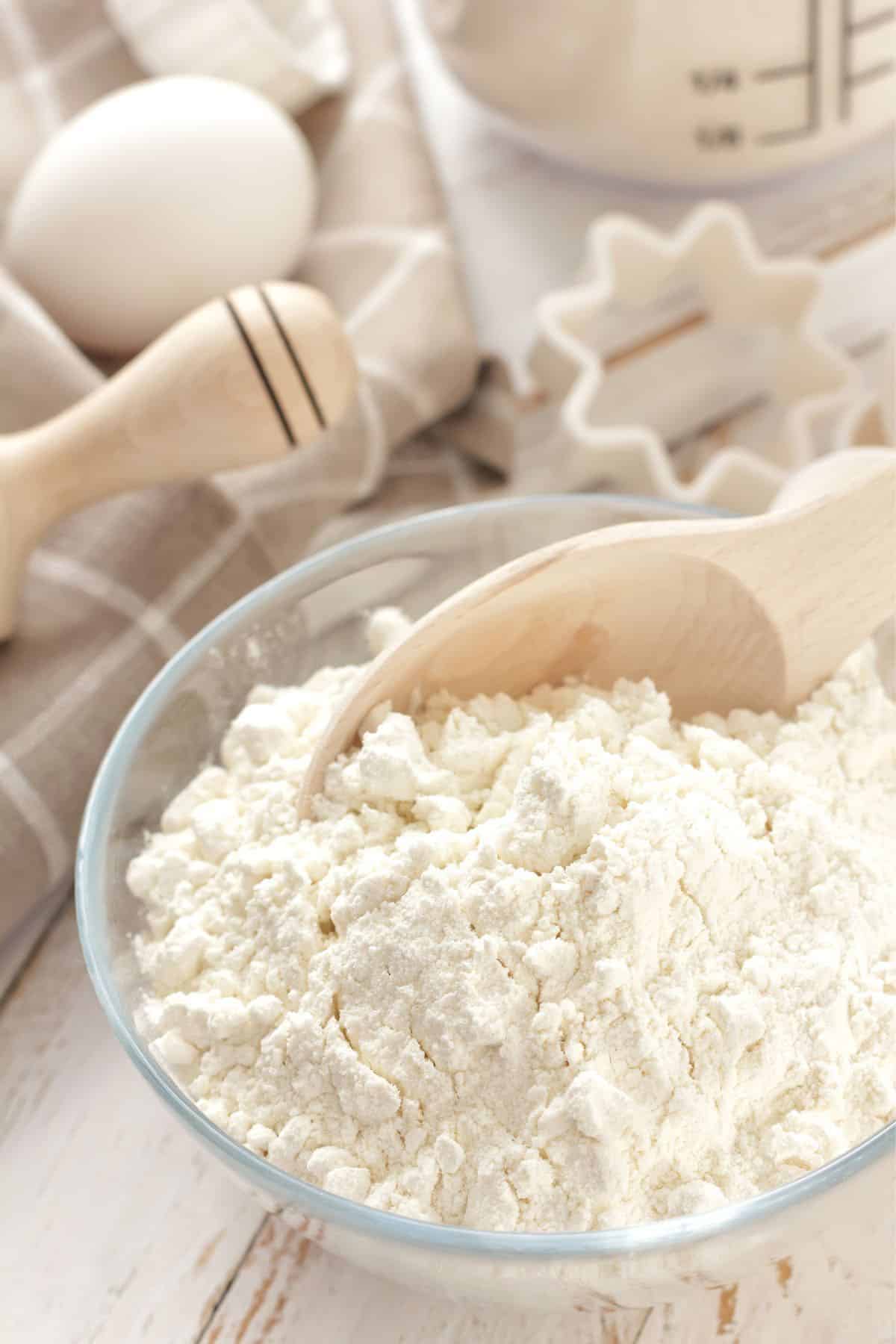
Jump to:
Is All-purpose flour the same as Plain flour?
Yes, in fact, all-purpose flour and plain flour are the very same thing. All-purpose flour is a term used by North Americans while plain flour is commonly used in the UK and Australia.
What is Flour
Flour is a powdery substance that is obtained by milling dry wheat grains or other starchy grains. Flour made of wheat grain, also known as wheat flour, is a famous basic ingredient of baked goods, however, flour can be also made from rye, corn, rice, etc.
History of flour
Flour has been an essential part of human civilization since a long time ago. Many people think that ancient humans lived solely on vegetables and meat. However, the historical findings show that humans have been making flour since around 30,000 years ago. People in the southern part of Italy were believed to be the first ones who produce flour using stone mortar and pestle in pre-historic times. The technology improved and then the Ancient Egyptians began sifting flour using hand sieves to get a finer texture in approximately 3000 B.C.E. The saddle stone method was then gradually replaced by traditional mills in the Ancient Greeks and Roman eras.
Did you know that March has the honor of being National Flour Month? So, don't forget to take a moment to appreciate flour as a prominent ingredient in our lives and do some baking!
The development of flour production
In North America, the first windmill was operated in Boston in 1632. During this time, flour still contained some coarse matter in it. In the 19th century, milling technology improved with the usage of steel rollers. With this automatic method, flour-milling improved in speed and quality since it only used the soft endosperm as the bran and germ were separated. This resulted in finely-milled white flour.
Following automation, people could buy the product more affordably so almost everyone could have flour in their house. Then, due to the awareness of nutritional deficiency, in the middle of the 20th century, flour started to be enriched with iron, riboflavin, and amino acids. At the end of the century, folic acid was also added to flour. Today, we can easily enjoy wheat flour that doesn't only contain carbs, fiber, and protein but also the micronutrients that are added to it.
💡 Top Tip: Did you know that you can even make your own flour at home? Yes, you can! In fact, it's fun and it can taste better and contain higher nutrients. So, grab your favorite wheat berries (choose your preferred varieties!) and grind the wheat using a countertop milling machine.
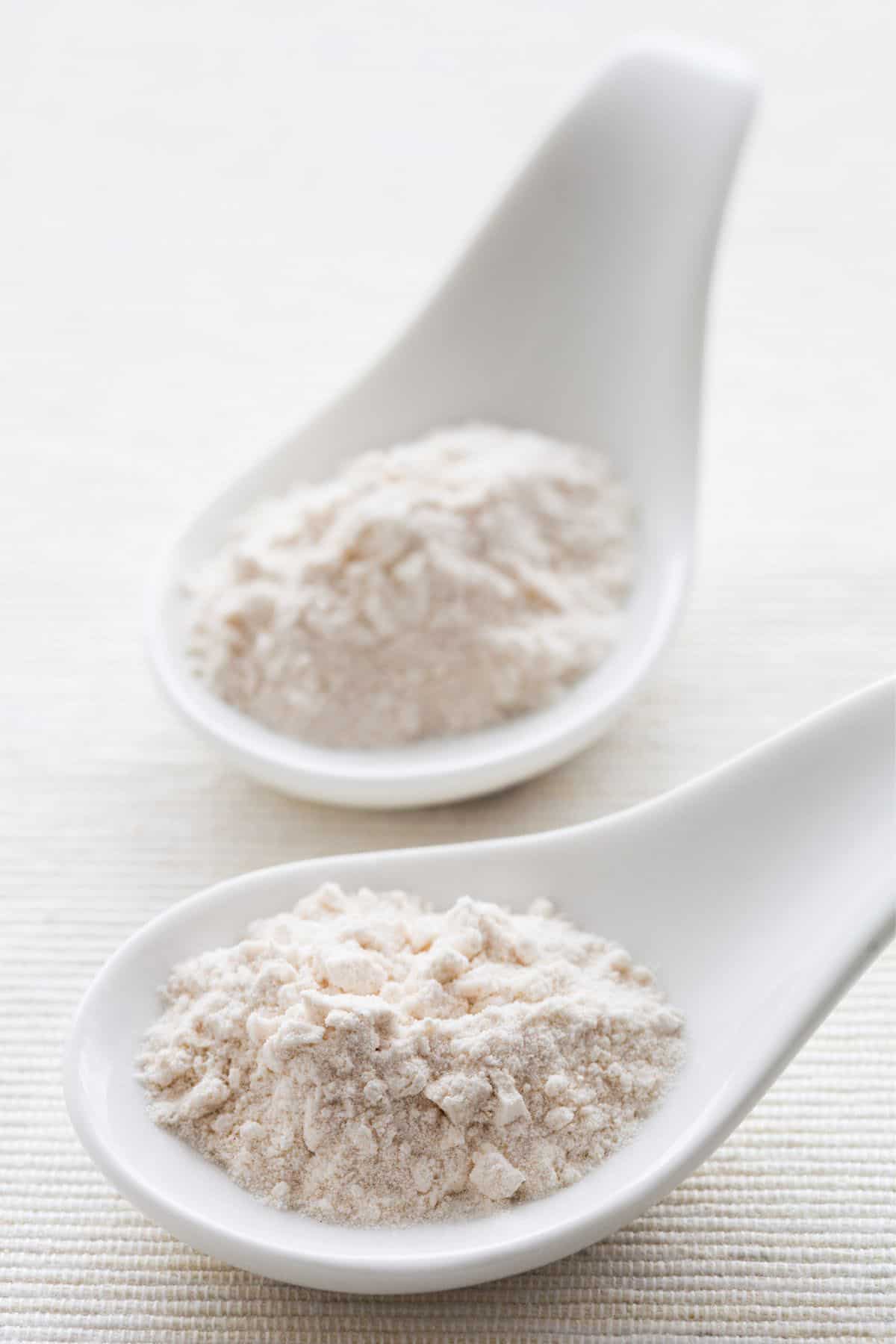
What is All-purpose flour
All-purpose flour is a medium protein flour that is made from wheat grains. The dry wheat grains are milled and sifted very finely until the white powdery substance remains without any coarse matter.
There are different kinds of white wheat flour; Flour with a high protein percentage (called bread flour) is good for making crusty bread and pasta, while flours with a low protein percentage (called cake flour) are good for making cakes. Purchasing different kinds of flour isn't always an option so, the industry developed a flour that suits (almost) all-purpose of baking. This flour is called "all-purpose flour" abbreviated as AP flour.
All-purpose flour has medium strength (medium protein percentage). It's made of hard wheat and soft wheat.
💡 Top Tip: All purpose flour, as the name indicates, can be used for "all purpose", however, the result won't be as perfect as choosing the ideal flour. So, always check what is the recommended flour in the recipe you are planning to make
The regional differences when it comes to All-purpose flour names
All purpose flour is one of the most popular baking ingredients in the world. However, it has got several different names. Internationally, all-purpose flour is sometimes abbreviated as "AP flour". In the United Kingdom and Australia, all-purpose flour is called "plain flour". In Germany, it's called "Flour Type 550", in France it is called "Flour type 55". In India, there is an Indian version of all purpose flour that is named "Maida", although it's more similar to cake flour since it contains less protein.
Why is flour white
Most flour has white color for three reasons. First, white flour is white because it's only made of the endosperm part of the wheat grain, instead of the whole kernel. Second, white flour is exposed to oxygen and turns into white (aging). Third, it may contain some chemical agent to help fasten the "aging" process.
White flour that has a true white color and softer texture typically has been chemically bleached. On the contrary, the yellowish-white flour doesn't have chemical agents to help speed up the aging process so it will bleach naturally. This naturally-bleached (also called unbleached) white flour usually looks a bit yellowish in color.
💡 Top Tip: Well, not all flour is white. There is also brownish-colored flour called whole wheat flour.
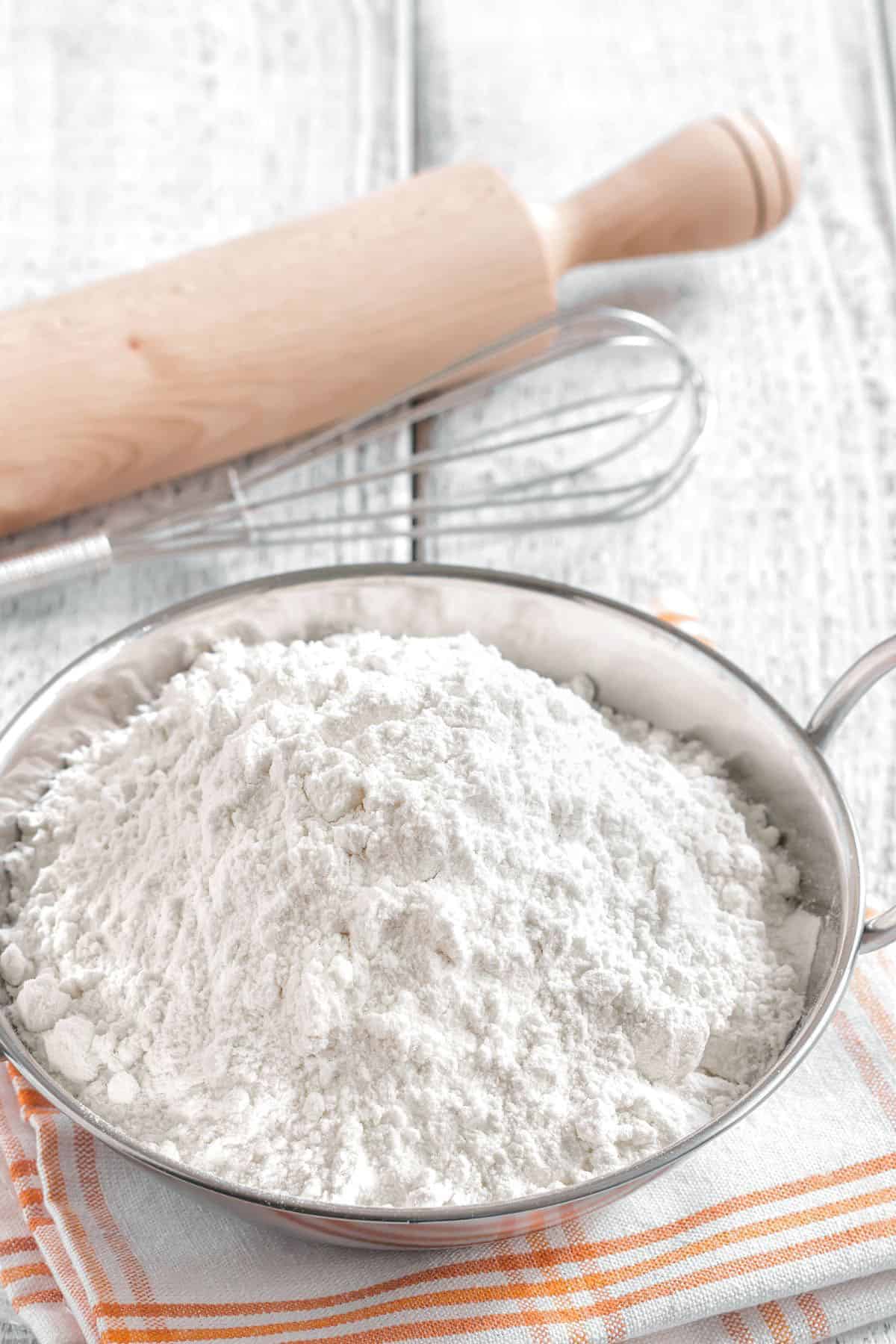
How does Flour work in baking
Flour contains various nutrients, including protein. There are two famous proteins in wheat flour, they are called glutenin and gliadin. These best friends will make a nice combo in baking as it will determine how soft or hard the structure of your baked goods is. When you add water to your flour, the glutenin and gliadin will combine to form gluten. Gluten is something elastic inside your dough that can stretch widely and trapped air inside your dough.
The importance of protein in the flour
Now, since the different type of flour has different protein content, the amount of gluten formed for each of them will also vary. Dough made using low-protein flour will have less, weaker gluten than dough made using high-protein flour. The higher the gluten, the better the structure. That's why bread requires high-protein flour while cake needs low-protein flour. High protein flour is perfect for making bread, babka, and choux pastry eg. eclair while low protein flour is great for making cupcakes and sponge cakes. So, protein contents determine the strength of a baked good.
The importance of gluten in the flour
Flour is known as the very important ingredient of almost every baked good because it provides structure. But the actual thing that provides structure is gluten, something that happens when gliadin and glutenin (both are proteins in flour) get in touch with water and bond together. Gluten is elastic and able to hold gas bubbles inside the dough. It means that the more gluten a dough has, the higher its ability to contain gas bubbles which also translates to open crumbs in bread.
Kneading a dough helps the gluten strands to expand and the better you knead the better the structure of the dough. Using high-protein flour means using a higher amount of gluten in your bread, which will result in a stronger dough. This type of dough is perfect for making crusty bread, brioche, and other yeast-based sweet bread. On the contrary, if you want to bake a cake, you don't want too much strength, more like a soft, moist texture in it, you will need low-protein flour.
💡 Top Tip: If you have tried my yeast-based recipes before, you must have seen that I always suggest kneading the dough until a so-called gluten window is achieved, which ensures the fluffiest most delicious texture on all your sweet bread.
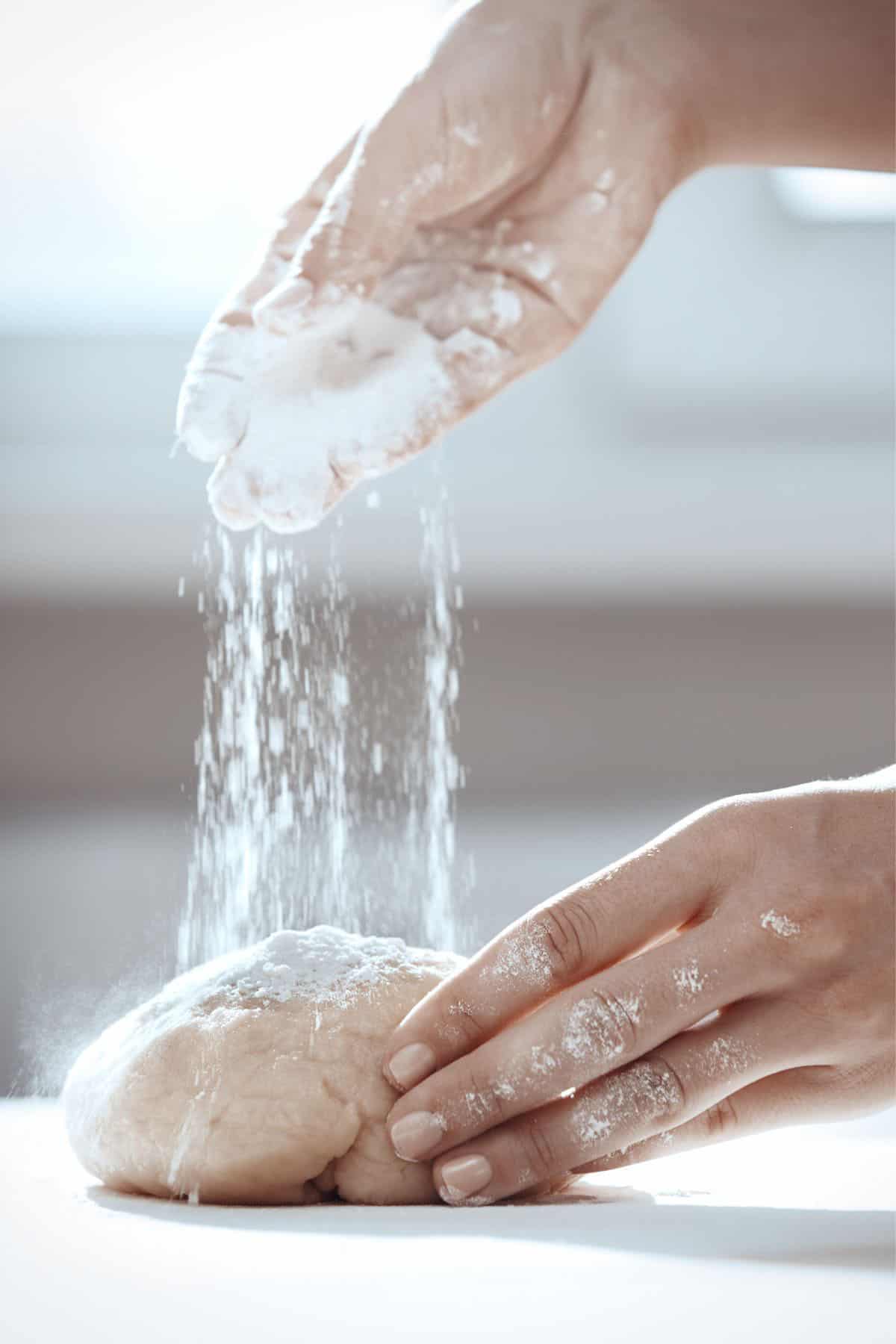
Types of Flours
There are so many kinds of flour in the world. In this post, we will talk specifically about types of wheat flour and their role in baking. Here are the different kinds of wheat flours:
1. Bread Flour
Bread flour is a kind of strong flour. It's made of hard spring wheat. Bread flour is also known as hard flour in the UK. This type of flour has the highest percentage of protein compared to other white wheat flour. When we look at all-purpose flour vs bread flour, bread flour combined with water will develop a bigger amount of gluten so it's perfect to make bread, croissant, babka, brioche, crusty pizza, and bagels, etc.
Is bread flour the same as wheat flour?
No, it's not. Bread flour contains a high percentage of protein while wheat flour contains a high percentage of fiber.
Is bread flour the same as cake flour?
Nope, they're not the same. In fact, they're quite the opposite in terms of protein percentage. Bread flour contains a high percentage of protein while cake flour has a low percentage of it.
2. Cake Flour
Cake flour, also known as soft flour is made by milling soft wheat, typically soft winter wheat. It has a lower protein content compared to other white wheat flour. When we look at plain flour vs cake flour, since cake flour has lower protein, the gluten forms in the dough will be in a smaller amount too. So this flour is perfect for making delicate or tender baked goods such as pound cakes, cookies, cakes, and muffins and cake flour will make their texture tender and airy.
How can I make cake flour from all-purpose flour?
If your recipe calls for cake flour while you only have all purpose flour at home, you can make homemade cake flour. To do this, for each cup of all-purpose flour (120g) add 2 tablespoon (15g) of cornstarch, then stir and sift.
3. Pastry Flour
Pastry flour is similar to cake flour, but with a slightly higher protein content. As the name suggests, pastry flour is great for making pastries. However, you can also use it to substitute cake flour in baking cookies and biscuits.
4. Plain Flour or All-Purpose Flour
All-purpose flour is a type of white flour made of hard and soft wheat varieties. So, it's a mixture of hard-protein flour and low-protein flour. This is probably the most common flour in everyday life. All-purpose flour can be used for various purposes and it is the go-to flour in most recipes, however, for the best results, it is always recommended to use the flour that is recommended in the recipe eg. cake flour for cakes, and strong bread flour for bread.
5. Self-raising Flour
Self-raising flour or self-rising flour is a type of white wheat flour that doesn't need an additional leavening agent to raise. This is because self-raising flour already contains baking powder so it can rise itself and salt (in some cases). I used to bake a lot with self-raising flour when I was living in the UK, and it gives consistent results, however, it is sometimes better to control the baking powder quantity by ourselves whether we want to achieve a lower or higher rise.
Is self-raising flour the same as bread flour?
No, it's not. Self rising flour is a kind of flour that has been added with a leavening agent while bread flour is a kind of pure flour with a high protein percentage.
Is self-raising flour the same as all-purpose flour?
Nope, they're not the same thing. Self-raising flour is a mixture of all-purpose flour, baking powder, and salt. It means that using all-purpose flour to replace self-raising flour will require you a leavening agent to add to the recipe.
Can I use self-raising flour instead of all-purpose flour?
If your recipe calls for all-purpose flour AND baking powder, you can replace them both with self-raising flour. Remember, since self-raising flour already contains a leavening agent, you don't need to add baking powder to the dough.
6. Whole Wheat Flour
The major difference between whole wheat and all-purpose flour is that during the milling process, the whole part of the kernels is used to make whole wheat flour. It will result in coarser flour with a brownish or yellowish texture. Whole wheat flour, also known as wholemeal flour in the UK, is made of whole red wheat berries. It has a bit nuttier in taste.
Whole wheat flour is very high in fiber compared to other wheat flour. It has various protein contents depending on the brand. You can use whole wheat flour to make chewy baked goods such as bread, however, since whole wheat flour absorbs more water than all-purpose flour, you will probably need to add additional liquid (water).
7. Semolina Flour
Semolina flour is made from durum wheat. It looks yellowish if not gold in color. The flavor is nutty and sweet. You can use it to make pasta, pizza, or bread.
💡 Top Tip: The protein content in each flour is the most important differentiator. Protein content will impact the overall texture and density of your baked products, but it won´t impact the taste (except whole wheat flour)
What kind of Flour should I use
Each flour has a different purpose. Which kind of flour should you use for different baked goods? It depends on your need. Remember this rule: the higher the protein content the stronger the structure. So, flour with a lower protein content such as cake flour is best for baking soft or tender baked goods such as biscuits and cake. Flour with high protein content is great for baking crusty, chewy bread.
All-purpose flour is great for general purposes and in most cases, able to replace the two flours above. If you prefer having a higher fiber in your baked goods, consider using whole wheat flour.

How to substitute flour
What I can substitute all-purpose flour with?
Technically, you can use either bread flour, pastry flour, or cake flour to replace all-purpose flour. The ratio is 1:1 which means you can substitute 100 grams of bread flour for all-purpose flour. However, remember that these flours have different protein contents and the result will slightly differ. In practice, do not recommend making bread with cake flour, similarly, it is not a good idea to make cakes with bread flour.
Gluten-free flour can be a good all purpose flour substitute too, eg. almond meal, rice flour, and corn flour, etc. but can only be done by slightly reformulating the recipe.
What flour is most similar to all-purpose flour?
In baking, when we talk about one ingredient being similar to another, we always have to obserb its nutritional properties, taste, color, texture etc. In this regard, if you are looking for the most similar flour to substitute all-purpose flour, you will have to mainly look for the protein content.
So, look for a flour that has about 10-12% protein content, finely milled, has a white color and that is the best all purpose-flour substitute.
How to substitute cake flour with all-purpose flour?
Cake flour contains less protein than plain flour. So if you insist on using all-purpose flour, you can use 1 cup minus 2 tablespoons of plain flour plus 2 tablespoons of corn starch. In grams, for each 120g flour take out 15g flour and replace it with 15g cornstarch.
How to substitute self-raising flour with all-purpose flour?
Self raising flour contains all-purpose flour and baking powder plus salt in most brands. To substitute self raising flour with all-purpose flour, you should use 1 teaspoon of baking powder for every 1 cup all-purpose plus ¼ teaspoon of salt. In grams, for each 120g flour add 4g baking powder plus 1.5g salt.
lease note that self-raising flour and its baking powder content varies by country, also different "rise" is required on eg. muffins vs. a pound cake, so best if you always follow the recipe.
Gluten-free Flour substitutes
If you’re looking for some gluten-free flours, try these options:
- Gluten-free all-purpose flour
- Almond flour
- Rice flour
- Tapioca flour
- Cassava flour
- Coconut flour
- Starch eg. potato starch
- Corn flour
- Oat flour
Please note that the above gluten-free flour options are always subject to the actual recipe and either can be partly substituted, or entirely, or not at all.
💡 Top Tip: In baked goods, where gluten is responsible for the entire structure development eg. bread, replacing wheat flour with gluten-free options requires careful consideration. In the meantime, pancakes, cookies, etc. can be easier made without the benefit of gluten.
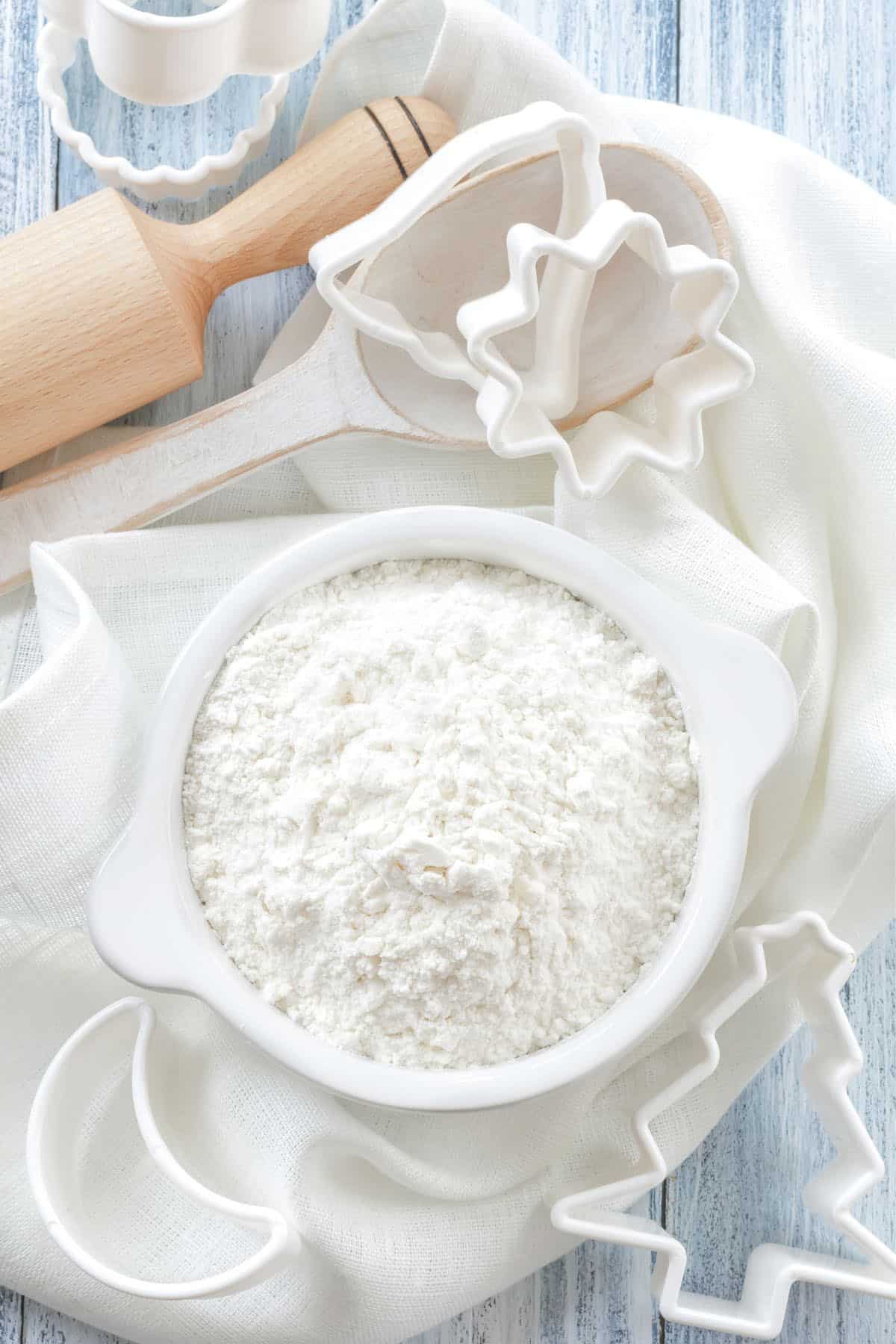
How to measure Flour
Flour has a special characteristic that can change the structure of your baked good, so you need to measure it the right way. To accurately measure your flour, you will need a Digital scale. Yes, you need to go with the metric system.
How to weight flour with a scale?
First, grab your digital scale and place a bowl on top of it. Turn on the digital scale. Press the tare button so the display is on zero grams. Then, using a spoon, add the flour into the bowl carefully. Depending on how much flour your recipe calls for, you can use a spoon or a big cup to take the flour from the bag. Keep adding the flour to the bowl until it reaches the required amount.
Easy peasy and no need to make dirty dishes with the cups, measure the flour into the actual bowl you will be using to mix the rest of the ingredients!
How to measure flour with cups?
First of all, please don't! A Digital scale is a $10 super affordable baking tool and it is the best investment you will make to succeed in baking, consistently! But, if for some reason your digital scale runs out of battery one day, you can go the old-fashioned way, but it's a bit tricky.
First, place your flour in a bag if you aren't already. Flour can be densely packaged so you need to stir the flour using a spoon until it's fluffy. Then, add the flour into a measuring cup gently, spoon by spoon. Build a heap of flour in the measuring cup until it goes past the rim. The next step is leveling up the flour using a knife to remove the excess flour.
And the amount of flour you have in the measuring cup is called "1 cup of flour" which should weigh around 120-125 grams. When measuring the volume of the flour, it's important to NOT directly scoop the flour using the measuring cup because it can be too dense and contains a bigger amount of flour.
💡 Top Tip: Not measuring flour correctly is the no 1. reason for dense or dry cakes, brownies, and cookies. Please try using a digital scale, and I promise, you will never go back to cups
If a Recipe Calls for Sifted Flour, Should You Sift It Before or After Measuring
It depends on the actual wording in the ingredient list. Take a look at the placement of the word "sifted". If it says "2 cups sifted flour" it means you need to sift the flour FIRST before measuring. If it says "300 grams of flour, sifted", it means that you need to measure the flour first before sifting.

Flour purchasing tips
First of all, when it comes to flour shopping you need to know exactly what you're looking for. As you have learned, there are different types of flour with different characteristics and purposes in baking. So, pick the ones you actually need. Then, follow these tips:
- Check the expiration date. Do not buy flour that is almost expiring.
- Make sure that the flour is properly sealed.
- Make sure that the store displays the flour in a cool and dry place.
Flour storage tips
First and foremost, make sure that your flour bag is closed tightly. You can also place the flour bag inside a clean big plastic bag to ensure that it's well-sealed. If you want to place it in the fridge or freezer, make sure to place your flour bag inside a dry airtight container.
You can conveniently store all-purpose flour in your kitchen cabinet or your pantry as long as it's cool and dry. Remember that flour absorbs odor easily so you need to place your flour away from strong-smelled foods such as onion. During your storage process, be sure to check it every once and a while (ideally once a week) to make sure that it's free from insects.
For more information on the different flour storage solutions and equipment, read my how to store flour guide.
💡 Top Tip: Do not forget to check the expiration date before baking with your flour. For longer storage, or if you live in a tropical climate and your kitchen is too warm and humid, store the flour in the freezer, where it can last for over a year as opposed to a few months.
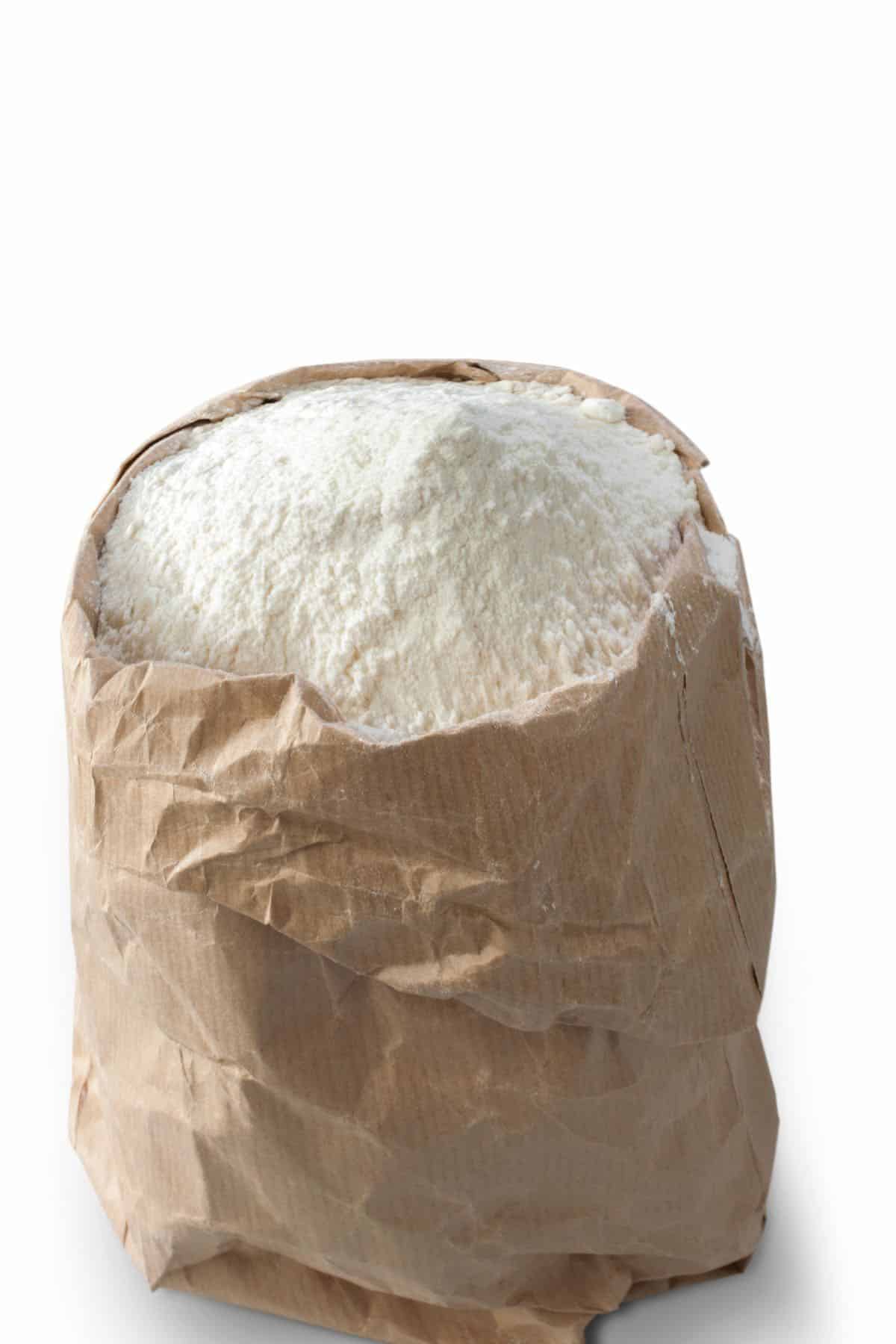
Flour FAQs
AP flour is the abbreviated version of all-purpose flour which is the same as plain flour
Yes, you can! They are the same thing. All-purpose flour is a term used by North Americans while plain flour is commonly used in the UK.
No, it's not. All-purpose flour is plain flour while self-raising flour is the mixture of plain flour + baking powder + salt
No, it´s not. Bread flour combined with water will develop a bigger amount of gluten so it's perfect to make eg. bread.
Yes, you can. However, the dough will be slightly wetter and the bread won't be as chewy as the one made with bread flour.
No, it is not. Cake flour is a low protein content flour giving moist and delicate texture to cakes, cupcakes, etc.
Yes, you can. You would get slightly better results using cake flour though. Or, why not make your own cake flour? For each cup of all-purpose flour (120g) add 2 tablespoons (15g) of cornstarch, then stir and sift
Soft flour eg. cake flour has lower protein content resulting in a delicate texture on baked goods eg. cakes. Most all-purpose flour is a mix of soft and hard flour
Yes, in many cases, you can, however, it is not a 1:1 swap in most cases and require careful consideration and reformulating the entire recipe

fafa abnoos
Thank you for the good information you wrote❤️🙏🏻
Neelam Sharma
How can I convert APF into high protein flour.can i use protein powder.If yes how much.
Kata
It is not possible to convert APF to high protein flour, the protein in the bread flour has different qualities than bread flour:)
Hope
I wanted to try to bake your basque cheesecake, since it looks so easy and delicious. As I read your instructions in the recipe about the temperature of the oven you stated (no fan) does this mean I can't make the basque cheesecake on a fan forced oven?
Kata
Basque burnt cheesecake can be baked in a fan-forced oven however you will want to reduce the temp by about 15C if baking it with a fan.
Mylene butler
Hi there you are very good with the flour can you help me please i have a recipe but it said wheat flour can't find that so i brought wholemeal flour will it work for me i don't eat white bread can you get back to me trying out this weekend i live in australia thanks for sharing your ideas
Kata
Wheat flour most probably means normal flour in your recipe. Wholemeal flour works quite differently.